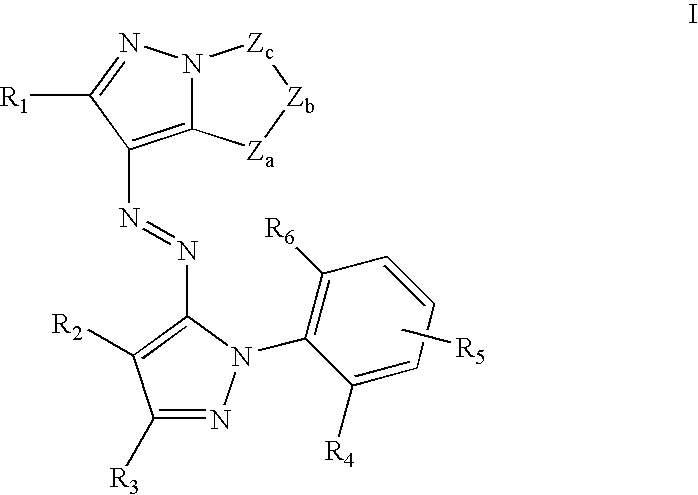Solubilized yellow dyes for inks with improved ozone and light stability
- Summary
- Abstract
- Description
- Claims
- Application Information
AI Technical Summary
Benefits of technology
Problems solved by technology
Method used
Image
Examples
examples
[0069] The following examples illustrate the utility of the present invention.
Preparation of Dyes
[0070] Azo dyes were prepared by synthetic methods disclosed in U.S. Pat. Nos. 6,174,356 and 4,685,934. Coupler materials were synthesized by methods disclosed in U.S. Pat. No. 5,248,786 and U.S. Pat. No. 5,972,574.
[0071] Dyes were initially made using the combinatorial method of parallel synthesis. (See Zhu, Q., Yoon, H., Parikh, P., Chang, Y., and Yao, S., Tetrahedron Letters 43 (2002), 5083-5086 for a descriptive example of the combinatorial method of synthesis). Typical libraries were composed of between 24-48 compounds, prepared in a matrix-like array (for a generic example, see Table 1) consisting of test tubes in a rack, each containing 0.5-3 mmol coupler dissolved in a mixture of a suitable water-miscible organic solvent (tetrahydrofuran or methanol) with at least one equivalent of sodium hydroxide and enough water to make a clear solution. The rack was cooled in an ice bath ...
PUM
 Login to View More
Login to View More Abstract
Description
Claims
Application Information
 Login to View More
Login to View More - R&D
- Intellectual Property
- Life Sciences
- Materials
- Tech Scout
- Unparalleled Data Quality
- Higher Quality Content
- 60% Fewer Hallucinations
Browse by: Latest US Patents, China's latest patents, Technical Efficacy Thesaurus, Application Domain, Technology Topic, Popular Technical Reports.
© 2025 PatSnap. All rights reserved.Legal|Privacy policy|Modern Slavery Act Transparency Statement|Sitemap|About US| Contact US: help@patsnap.com



